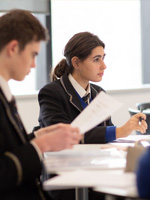

|
Group 5 - Mathematics
Aims
The aims of each of the courses in Group 5 are to enable students to:
- develop a curiosity and enjoyment of mathematics, and appreciate its elegance and power;
- develop an understanding of the concepts, principles and nature of mathematics;
- communicate mathematics clearly, concisely and confidently in a variety of contexts;
- develop logical and creative thinking, and patience and persistence in problem-solving to instil confidence in using mathematics;
- employ and refine their powers of abstraction and generalisation;
- take action to apply and transfer skills to alternative situations, to other areas of knowledge and to future developments in their local and global communities;
- appreciate how developments in technology and mathematics influence each other;
- appreciate the moral, social and ethical questions arising from the work of mathematicians and the applications of mathematics;
- appreciate the universality of mathematics and its multicultural, international and historical perspectives;
- appreciate the contribution of mathematics to other disciplines, and as a particular 'area of knowledge' in the TOK course;
- develop the ability to reflect critically upon their own work and the work of others;
- independently and collaboratively extend their understanding of mathematics.
Both courses MAA and MAI (SL and HL) cover the same 5 topics within mathematics but with varying emphasis in each area: number and algebra, functions, geometry and trigonometry, statics and probability, and calculus.
Mathematics – Analysis and Approaches SL (MAA SL)
- Enable the student to develop a sound basis of mathematical skills and knowledge in order to facilitate the further study of mathematically related subjects at University. This mathematics is of an equivalent standard to VCE Mathematical Methods. This course explores mathematical concepts in real and abstract applications with and without technology.
- It is recommended students achieving an average of 65% or higher in Year 10 Methods Analysis can choose this course for their IB Pathway.
Mathematics – Analysis and Approaches HL (MAA HL)
- Enable the student to develop a sound basis of mathematical skills and knowledge in order to facilitate the further study of mathematics. This is the most demanding IB mathematics course offered by Carey. This course explores mathematical concepts in real and abstract applications with and without technology.
- It is recommended students achieving an average of 85% or higher in Year 10 Methods Analysis choose this course for their IB pathway.
Mathematics – Applications and Interpretations SL (MAI SL)
- Enable the student to develop a sound basis of mathematical skills and knowledge in order to describe the real world and solve practical problems. This subject harnesses technology to explore mathematical models in a practical application. All assessments utilise technology. This course is the easiest of the Mathematics courses on offer in the IB.
- It is recommended students achieving an average of 60% or higher in Year 10 Further Applications choose this course for their IB pathway.
Objectives
In all Group 5 courses students are expected to:
- know and use mathematical concepts and principles;
- read and interpret a given problem in appropriate mathematical terms;
- organise and present information/data in tabular, graphical and/or diagrammatic forms;
- know and use appropriate notation and terminology;
- formulate a mathematical argument and communicate it clearly;
- select and use appropriate mathematical techniques;
- understand the significance and reasonableness of results;
- recognise patterns and structures in a variety of situations and draw inductive generalisations;
- demonstrate an understanding of, and competence in, the practical applications of mathematics;
- use appropriate technological devices as mathematical tools.
|


